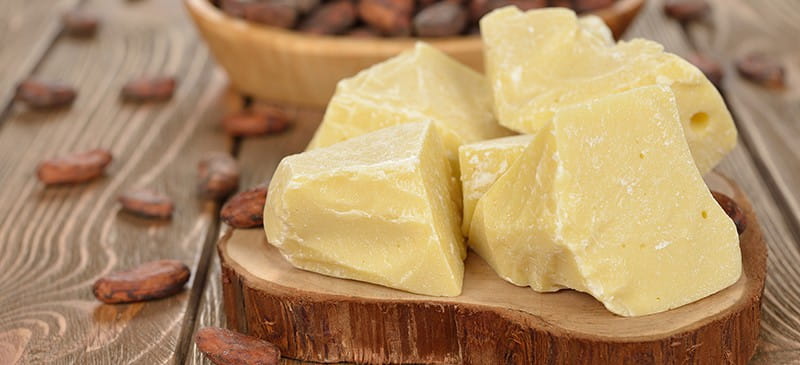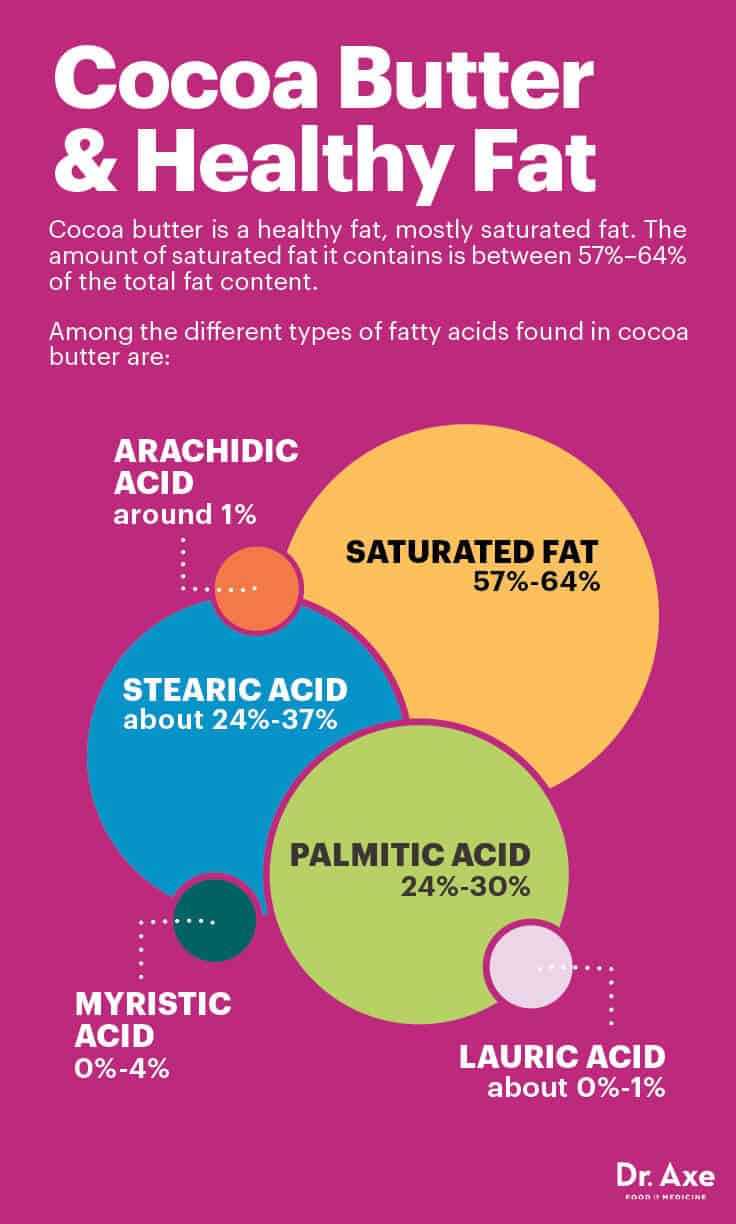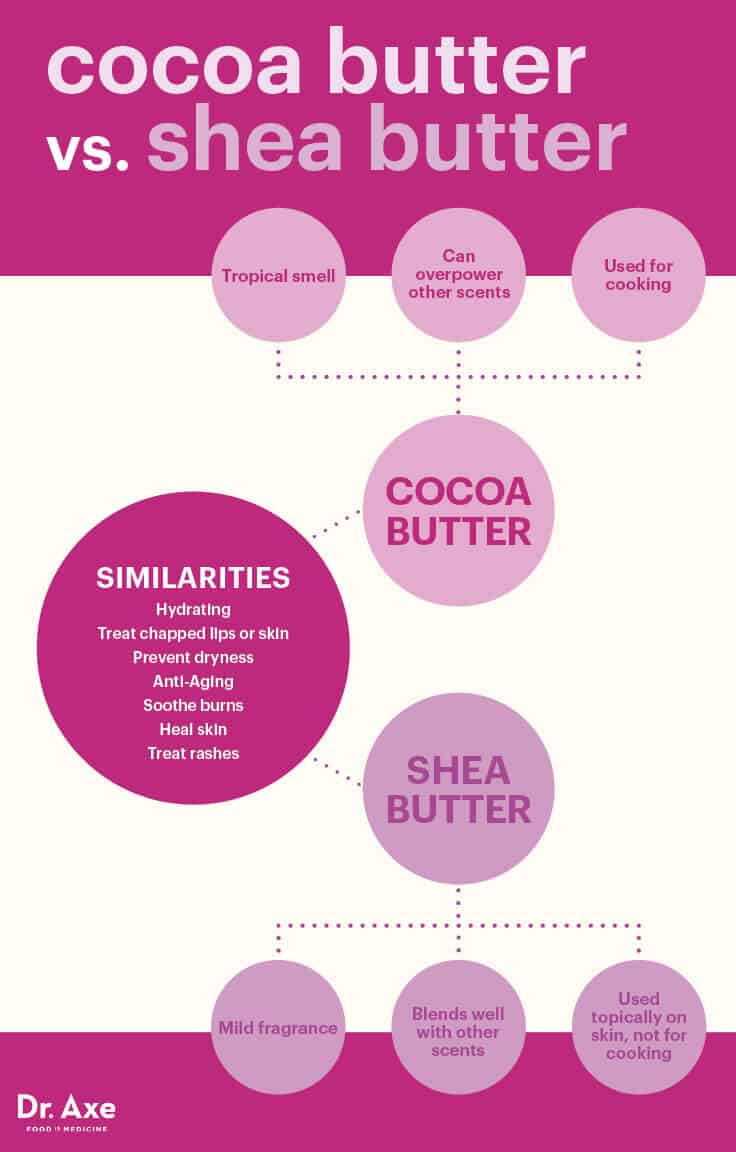The Versatile Uses of Cocoa Butter
Whether you realize it or not, you’ve probably eaten cocoa butter many times in your life — plus smeared it onto your skin. It’s the fat source used to make chocolate, giving it its alluring, melt-in-your-mouth, silky feel. It can be found in basically all types of chocolate, including dark, milk or white.
What else is cocoa butter good for? Just like other skin-loving fats — such as raw shea butter and coconut oil — cocoa butter is great for naturally healing dry, sensitive skin. And in terms of your diet, as explained more below, cocoa butter benefits include providing healthy fatty acids that support the immune system, cardiovascular system, cognitive function and appetite control.

What Is Cocoa Butter?
Cocoa butter (sometimes called theobroma oil) is a natural, meltable oil that’s extracted from the cocoa bean. Cocoa beans are seeds from the Theobroma cacao L. plant, a member of the Sterculiaceae plant family.
These beans are used to make “one of the most important and widespread functional foods in human history”: chocolate. Historians believe that cocoa beans have been grown for more than 3,000 years and were prized among ancient populations, including the Mayan and Aztec civilizations.
Can you eat cocoa butter? Yes! Real cocoa butter is completely edible and has a faint taste and smell similar to dark chocolate. The beans from the theobroma cacao L. plant are a high-antioxidant food, since they contain a significant amount of polyphenol and flavonoid antioxidants. In fact, cocoa beans themselves have been shown to be one of the greatest suppliers of polyphenols in the human diet.
Cocoa beans are native to parts of Central and South America and have been harvested to make natural skin moisturizers in places like Mesoamerica and the Caribbean for centuries. Because it has a mild fragrance, a smooth texture (due to its “emollient” properties) and is ultra-hydrating, cocoa products are very popular ingredients in all sorts of commercial beauty products — including skin lotions, lip glosses, chapsticks, hair conditioners and other beauty ointments.
Is cacao butter the same as cocoa butter? Cocoa butter products vary depending on how the beans are processed and heated. The spelling “cacao” usually means that the beans are unroasted (or “raw”).
Nutrition Facts
Cocoa butter is high in fat, mostly saturated fat, just like coconut oil. The amount of saturated fat it contains (as opposed to unsaturated fat) is between 57 percent to 64 percent of the total fat content, depending on the exact kind. Among the different types of fatty acids are:
- stearic acid (about 24 percent to 37 percent of total fat content)
- palmitic acid (24 percent to 30 percent)
- myristic acid (0 percent to 4 percent)
- arachidic acid (around 1 percent)
- lauric acid (only about 0 percent to 1 percent)
Types
Here’s how different types compare:
- To make cocoa butter, cocoa beans are first fermented then roasted. At this point, the cocoa “butter” (which isn’t actually the kind of butter made from any type of milk at all) is able to be separated from the rest of the beans, leaving behind solids that are used for other purposes like making cocoa powder.
- While cocoa butter does contain some polyphenols and other antioxidants, it doesn’t supply as much as dried cocoa powder does.
- Many brands deodorize and de-colorize cocoa butter so the product is a yellow-beige color and smells pretty neutral, not much like cocoa liquor or chocolate.
- To make chocolate, cocoa butter is then further pressed to release “chocolate liquor,” which holds most of the chocolate taste and smell.
- Raw cocoa butter, sometimes labeled as “pure cocoa butter,” isn’t heated to very high temperatures during manufacturing processes, which means it usually retains more of the healthy fats and other compounds found naturally in cocoa beans. Similarly, raw cacao powder is made by cold-pressing unroasted cocoa beans. To be considered raw, temperatures usually don’t exceed about 115 F.

Health Benefits
1. Prevents Skin Dryness and Peeling
Why is cocoa butter good for your face? While it’s an excellent skin moisturizer, it does more than just hydrate the skin — it helps actually heal it from the inside out too. It’s a great source of natural antioxidants that are found in cocoa beans, plus fatty acids that are easily absorbed and remain on the skin for hours.
Natural hydrating products also tend to cause much less irritation to the skin than products made with additives, fragrances, colors and dyes.
To use it on your skin to treat or prevent dryness and peeling, try mixing it with other beneficial products like essential oils or argan, castor or jojoba oil. If you have extra dry skin (such as eczema), always use pure cocoa butter and perform a patch test first to make sure you don’t have a sensitivity and wind up developing any negative reactions.
If your cocoa butter is very solid due to being stored in your home in a cool place, try combining it with a bit of hot water to make it melt. You can boil some water on the stove and then pour it onto a handful of cocoa butter to make it more spreadable. Some people find that black cocoa butter is the softest and spreads onto skin best without needing to be warmed much, but that commercial, deodorized cocoa butters are more brittle and hard.
2. Heals Chapped Lips
One of the most popular ways to use cocoa butter is on chapped lips, especially in homemade lip balms. It can be used with grapefruit, vanilla, orange or peppermint oil to make flavorful lip palms that are also hydrating for delicate skin.
Cocoa butter is an emollient, which means it adds a protective layer of hydration to your lips, useful for blocking the effects of very cold temperatures, sun damage or indoor heat, which can leave your lips dry.
3. Fights Signs of Aging
Cocoa butter contains compounds called cocoa mass polyphenols, which some studies have found can help diminish signs of aging, plus soothe sensitive skin suffering from dermatitis or rashes.
Polyphenols are types of antioxidants that promote health both internally when eaten and when used topically on the skin. Cocoa’s polyphenols have been found to fight various chronic diseases, degeneration of the skin, sensitivities and even cell mutations.
Research shows that its polyphenols have several positive indicators for skin health, including reducing photoaging, improved skin elasticity and skin tone, better collagen retention/production, and better hydration.
When comparing cocoa butter to commercially available products, studies have shown that both can have positive results, but only cocoa butter is free from potentially harmful or irritating ingredients.
4. Soothes Burns, Rashes and Infections
You can rub a small amount of pure cocoa butter into burnt skin to help skin replenish. Just make sure it’s pure and doesn’t contain any alcohol, fragrances/perfumes or other additives that can lead skin to become even more inflamed and sensitive.
It’s even gentle enough to be used as a natural treatment for eczema, dermatitis and skin rashes. Aloe vera gel or tea tree essential oil are two great additions for applying to burnt or damaged skin.
5. Helps Treat Mouth Sores
If the inside of your mouth is prone to developing painful sores, or your lips develop recurring blisters, try using a bit of cocoa butter to keep them moisturized. Preventing too much dryness in the inside on the lips and in the mouth is one way to help prevent sores and blisters from forming.
6. Makes a Great Shaving Cream
You can use cocoa butter in your tub to shave and hydrate skin at the same time. It melts easily in warm water and won’t clog your drain.
Use a small handful before shaving to prevent nicks and to leave just-shaven skin feeling nice and smooth. After showering is another great time to slather it on, since heat opens up pores and makes it absorb products better.
7. May Help Improve Heart Health
While saturated fats used to be frowned upon and blamed for contributing to heart problems, today many researchers believe that plant-derived saturated fats can actually be beneficial for reducing the risk of cardiovascular diseases.
The polyphenolic components found in cocoa butter have been shown in certain studies to help lower inflammatory markers involved in atherosclerosis (hardening of the arteries), which is why cocoa is now considered an anti-inflammatory food.
Cocoa also seems to help with lipid (fat) metabolism and is linked with a decreased risk for vascular events, such as a heart attack.
8. Provides Antioxidants That May Fight Inflammation
Some antioxidants remain in cocoa butter even after it’s separated from the beans’ solids, which means it may be beneficial for lowering inflammation.
Many studies have shown that plant polyphenols exert antioxidant powers within the immune system, fighting inflammation, DNA damage and cellular mutations, which are the underlying cause of diseases like cardiovascular disease, cancer and autoimmune conditions.
9. Provides Fatty Acids That Support Brain Health
Fats in your diet, especially cholesterol and saturated fat, are vitally important for brain health and maintaining a positive mood, in addition to supporting hormone production and controlling your appetite. Fats serve as building block for brain cells and are needed to make to sex hormones including estrogen, progesterone and testosterone, which control numerous bodily processes.
What About Cocoa Butter for Stretch Marks?
Around the Web, one of the most popular uses for cocoa butter is preventing or treating stretch marks, especially during pregnancy. Does this method actually work? Overall, study results have been mixed regarding its efficacy for getting rid of stretch marks.
Many people report improvements in visible stretch marks after using it, but certain studies have found that compared to placebo treatments, women don’t actually show significantly more improvements when using lotion made with cocoa butter. There’s no harm in trying it for preventing stretch marks, but it doesn’t seem to reverse those that have already formed.
Cocoa Butter vs. Other Moisturizers
Shea Butter
Since they have similar uses and benefits for the skin, it might really come down to preference when it comes to using shea butter versus cocoa butter on your skin. Both are hydrating, time-old ways to treat chapped lips and prevent dryness. You can also use both together to boost their effects, especially if you have eczema or psoriasis.
Two of the differences between these products is their smell and how they can be used. Many people prefer cocoa butter’s tropical smell over shea butter’s very mild fragrance. On the other hand, shea butter has a neutral smell that means it blends well with other essential oil scents. Cocoa butter is also used to cook with, while shea butter is used only topically on the skin.

Coconut Oil
These two products have similar hydrating properties, as the benefits of coconut oil for skin mimic those of cocoa butter. However, coconut oil has some added benefits, including antibacterial properties. This might make it more practical for you to keep at home, since it has dozens of different uses in the kitchen and bathroom.
Coconut oil contains fatty acids that keep skin healthy and clean, including capric acid, lauric acid and caprylic acid. It melts when rubbed into the skin or heated, and it has a smooth feel and pleasant smell/taste. Feel free to use both together or for different purposes, such as cocoa butter on your lips but oil on your hair.
How to Use
Cocoa butter remains solid at room temperature, but melts at higher temps, such as those within the human body. This is what allows it to be rubbed into the skin, and what makes it a good fat to cook or bake with.
It has a melting point of around 93–101 degrees F, which means it becomes liquid once ingested or sometimes when applied topically. It’s ability to melt gives it an attractive “mouth feel” when added to chocolate, or when used in creamy lotions.
The Best Cocoa Butter Products to Buy:
Where can you buy cocoa butter? Look in health food stores, Asian markets, and online.
Ideally, purchase organic, pure cocoa butter. Cocoa butter prices vary depending on the type of product. Pure cocoa butter gives you the most benefits, but it’s harder to find and more expensive than blended products that mix cocoa butter with other fillers or oils.
How can you tell if a cocoa product is high quality? Read ingredient labels and look at the color: pure cocoa butter usually has a lighter color than commercial cocoa butters, which tend to be a deeper yellow.
When purchasing cocoa butter, try to avoid kinds that are sold as white, silky lotions and come in pump bottles or squeezable bottles. Products like this might contain some cocoa butter, but they’re far from pure and likely contain many other additives, which is exactly how they stay one uniform texture and color (which real cocoa butter doesn’t do).
You can make your own easy-t0-use cocoa butter sticks at home, which ensures that you get the most benefits and put the least amount of junk on your skin.
Buy a slab of real cocoa butter online or from a natural retailer, then break off or shave off a little piece and put it inside an old chapstick container. You can rub this directly into your skin and easily keep it in your bag or elsewhere. Or you can simply mash up the solid butter and add several drops of essential oils to make a silky homemade body butter lotion.
Because it’s so stable, it’s believed to last for more than two years. Many people keep the same jar of cocoa butter for two to five years, since its saturated fat is resilient against rancidity and spoilage.
Cooking and Cocoa Butter Recipes:
One of the biggest advantages of cocoa butter is that it’s a very “stable” fat, meaning it isn’t likely to spoil and become rancid when heated. Unlike more delicate fat sources, such as those rich in polyunsaturated fat (like vegetable oils) or monounsaturated fat (like olive oil), saturated fats retain their nutrients and chemical composition easily even when manufactured and used in cooking. This helps preserve many of the benefits of cocoa butter, such as its antioxidants.
If you want to use cocoa butter for cooking, here’s some ideas and tips:
- One of the most popular ways to cook with cocoa butter is to make homemade chocolate by combining it with coconut palm sugar, maple syrup or raw honey and cocoa powder.
- You can also melt it into a raw chocolate syrup or make a chocolate mousse or chocolate coconut pudding.
- Try it in this Soft, Chewy Chocolate Chip Cookies Recipe or Dark Chocolate Soufflé Recipe.
- Desserts might be its most popular use, but raw cocoa butter also makes a great butter or dairy substitute and can be used in various ways just like coconut oil.
Is cocoa butter vegan? Yes, since it doesn’t actually contain any real butter (a dairy product) at all, but rather comes from a plant.
Risks and Side Effects
Cocoa products are high in fat and calories, which means it’s best to consume them in small to moderate amounts.
If you’re looking for the most bang-for-your-buck in terms of antioxidant content, focus on having dark chocolate from cocoa powder rather than cocoa butter. Cocoa powder has been shown to have higher polyphenol content, especially when you go for the dark stuff and make sure it’s a high percentage (research shows you can obtain the highest phenolic content from cocoa by eating dark chocolate/dark “baking chocolate”).
Final Thoughts
- What is cocoa butter? It’s a natural, meltable oil that’s extracted from the cocoa beans, which are seeds from the Theobroma cacao L. plant. It’s the fat source used to make chocolate and is also great for naturally moisturizing skin.
- Not only is this butter completely edible, but cocoa butter products are also used to make hydrating skin lotions, creams, lip glosses, chapsticks and other beauty ointments.
- Its benefits include hydrating skin; healing chapped lips; fighting signs of aging; soothing burns, rashes and infections; treating mouth sores; working as a shaving cream; supporting cardiovascular health; and potentially reducing inflammation.





Leave a comment